Philips PCF8578H-F1, PCF8578T, PCF8578U, PCF8578U-10, PCF8578U-12 Datasheet
...
INTEGRATED CIRCUITS
DATA SHEET
PCF8578
LCD row/column driver for dot matrix graphic displays
Product specification |
1998 Sep 08 |
Supersedes data of 1997 Mar 28
File under Integrated Circuits, IC12

Philips Semiconductors |
Product specification |
|
|
LCD row/column driver for dot matrix
PCF8578
graphic displays
CONTENTS
1FEATURES
2APPLICATIONS
3GENERAL DESCRIPTION
4ORDERING INFORMATION
5BLOCK DIAGRAM
6PINNING
7FUNCTIONAL DESCRIPTION
7.1Mixed mode
7.2Row mode
7.3Multiplexed LCD bias generation
7.4Power-on reset
7.5Internal clock
7.6External clock
7.7Timing generator
7.8Row/column drivers
7.9Display mode controller
7.10Display RAM
7.11Data pointer
7.12Subaddress counter
7.13I2C-bus controller
7.14Input filters
7.15RAM access
7.16Display control
7.17TEST pin
18 SOLDERING
18.1Introduction
18.2Reflow soldering
18.3Wave soldering
18.3.1LQFP
18.3.2VSO
18.3.3Method (LQFP and VSO)
18.4Repairing soldered joints
19DEFINITIONS
20LIFE SUPPORT APPLICATIONS
21PURCHASE OF PHILIPS I2C COMPONENTS
8 |
I2C-BUS PROTOCOL |
8.1Command decoder
9 |
CHARACTERISTICS OF THE I2C-BUS |
9.1Bit transfer
9.2Start and stop conditions
9.3System configuration
9.4Acknowledge
10LIMITING VALUES
11HANDLING
12DC CHARACTERISTICS
13AC CHARACTERISTICS
14APPLICATION INFORMATION
15CHIP DIMENSIONS AND BONDING PAD LOCATIONS
16CHIP-ON GLASS INFORMATION
17PACKAGE OUTLINE
1998 Sep 08 |
2 |

Philips Semiconductors |
Product specification |
|
|
LCD row/column driver for dot matrix
PCF8578
graphic displays
1 FEATURES
·Single chip LCD controller/driver
·Stand-alone or may be used with up to 32 PCF8579s (40960 dots possible)
·40 driver outputs, configurable as 32¤8, 24¤16, 16¤24 or 8¤32 rows/columns
·Selectable multiplex rates; 1 : 8, 1 : 16, 1 : 24 or 1 : 32
·Externally selectable bias configuration, 5 or 6 levels
·1280-bit RAM for display data storage and scratch pad
·Display memory bank switching
·Auto-incremented data loading across hardware subaddress boundaries (with PCF8579)
·Provides display synchronization for PCF8579
·On-chip oscillator, requires only 1 external resistor
·Power-on reset blanks display
·Logic voltage supply range 2.5 to 6 V
·Maximum LCD supply voltage 9 V
·Low power consumption
·I2C-bus interface
·TTL/CMOS compatible
·Compatible with most microcontrollers
·Optimized pinning for single plane wiring in multiple device applications (with PCF8579)
·Space saving 56-lead plastic mini-pack and 64 pin quad flat pack
·Compatible with chip-on-glass technology.
2 APPLICATIONS
·Automotive information systems
·Telecommunication systems
·Point-of-sale terminals
·Computer terminals
·Instrumentation.
3 GENERAL DESCRIPTION
The PCF8578 is a low power CMOS LCD row/column driver, designed to drive dot matrix graphic displays at multiplex rates of 1 : 8, 1 : 16, 1 : 24 or 1 : 32. The device has 40 outputs, of which 24 are programmable,
configurable as 32¤8, 24¤16, 16¤24 or 8¤32 rows/columns. The PCF8578 can function as a stand-alone LCD
controller/driver for use in small systems, or for larger systems can be used in conjunction with up to
32 PCF8579s for which it has been optimized. Together these two devices form a general purpose LCD dot matrix driver chip set, capable of driving displays of up to 40960 dots. The PCF8578 is compatible with most microcontrollers and communicates via a two-line bidirectional bus (I2C-bus). Communication overheads are minimized by a display RAM with auto-incremented addressing and display bank switching.
4 ORDERING INFORMATION
TYPE NUMBER |
|
PACKAGE |
|
|
|
|
|
||
NAME |
DESCRIPTION |
VERSION |
||
|
||||
|
|
|
|
|
PCF8578T |
VSO56 |
plastic very small outline package; 56 leads |
SOT190-1 |
|
|
|
|
|
|
PCF8578U/2 |
- |
chip with bumps in tray |
- |
|
|
|
|
|
|
PCF8578H |
LQFP64 |
plastic low profile quad flat package; 64 leads; body 10 ´ 10 ´ 1.4 mm |
SOT314-2 |
|
|
|
|
|
1998 Sep 08 |
3 |
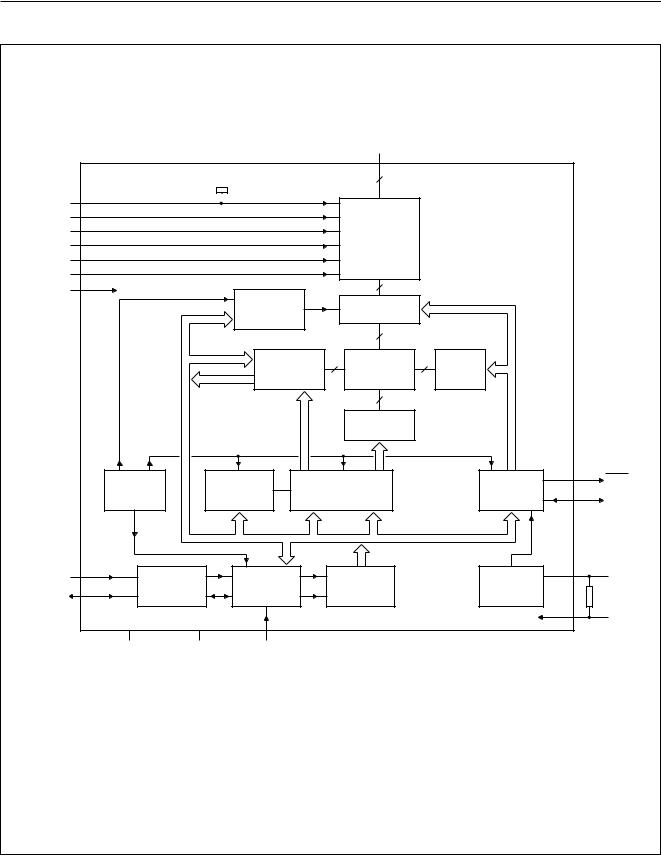
Philips Semiconductors |
Product specification |
|
|
LCD row/column driver for dot matrix
PCF8578
graphic displays
5 BLOCK DIAGRAM
|
|
|
|
|
|
C39 - C32 |
|
|
|
|
|
|
|
|
|
|
R31/C31 - R8/C8 |
|
|
|
|
|
|
|
|
|
|
R7 - R0 |
|
|
|
|
|
|
|
|
|
|
17 - 56 |
|
|
|
|
|
|
|
|
|
|
(29 to 35, 37, 38 to 46 |
|
|
|
|
VDD |
9 (20) |
|
|
|
|
48 to 62, 63, 64, 1 to 6) |
|
|
|
|
|
|
|
|
|
|
|
|
|
||
V2 |
10 (21) |
|
|
|
|
|
|
|
|
|
11 (22) |
|
|
|
|
|
|
|
|
|
|
V3 |
|
|
|
|
(1) |
|
|
|
|
|
12 (23) |
|
|
|
|
ROW/COLUMN |
PCF8578 |
|
|
|
|
V4 |
|
|
|
|
DRIVERS |
|
|
|
||
13 (24) |
|
|
|
|
|
|
|
|
|
|
V5 |
|
|
|
|
|
|
|
|
|
|
14 (25) |
|
|
|
|
|
|
|
|
|
|
VLCD |
|
|
|
|
|
|
|
|
|
|
6 (12) |
|
|
|
|
|
|
|
|
|
|
TEST |
|
|
|
|
|
|
|
|
|
|
|
|
|
DISPLAY |
|
|
|
|
|
|
|
|
|
|
|
|
OUTPUT |
|
|
|
|
|
|
|
|
|
MODE |
|
|
|
|
|
|
|
|
|
|
|
CONTROLLER |
|
|
|
|
|
|
|
|
|
CONTROLLER |
|
|
|
|
||
|
|
|
|
|
|
|
|
|
||
|
|
|
|
Y DECODER |
32 x 40-BIT |
DISPLAY |
|
|
|
|
|
|
|
|
AND SENSING |
|
|
|
|||
|
|
|
|
DISPLAY RAM |
DECODER |
|
|
|
||
|
|
|
|
AMPLIFIERS |
|
|
|
|||
|
|
|
|
|
|
|
|
|
||
|
|
|
|
|
|
X DECODER |
|
|
|
|
|
|
|
|
|
|
|
|
(9) 3 |
|
SYNC |
|
POWER-ON |
SUBADDRESS |
|
|
TIMING |
|
|
|||
|
RAM DATA POINTER |
(10) 4 |
|
|
||||||
|
RESET |
|
COUNTER |
GENERATOR |
|
CLK |
||||
|
|
Y |
X |
|
|
|||||
|
|
|
|
|
|
|
|
|||
|
|
|
|
|
|
|
|
|
||
SCL |
2 (8) |
|
|
I2C-BUS |
|
|
|
(16) 8 |
|
OSC |
|
INPUT |
|
|
COMMAND |
|
|
|
|||
1 (7) |
|
|
OSCILLATOR |
|
|
|
||||
|
FILTERS |
|
CONTROLLER |
|
DECODER |
|
R |
|
||
SDA |
|
|
|
|
OSC |
|||||
|
|
|
|
|
|
|
|
|||
|
|
|
|
|
|
|
|
|
|
|
|
|
(14, 15, 17 to 19 |
|
|
|
|
(11) 5 |
|
VSS |
|
|
15, 16 |
7 (13) |
|
|
|
|
|
|||
|
26 to 28 |
36, 47) |
|
|
|
|
|
|
||
|
n.c. |
n.c. |
|
|
|
|
MSA842 |
|
|
|
|
SA0 |
|
|
|
|
|
|
|||
(1) Operates at LCD voltage levels, all other blocks operate at logic levels. The pin numbers given in parenthesis refer to the LQFP64 package.
Fig.1 Block diagram.
1998 Sep 08 |
4 |

Philips Semiconductors |
Product specification |
|
|
LCD row/column driver for dot matrix
PCF8578
graphic displays
6 PINNING
|
SYMBOL |
|
PIN |
DESCRIPTION |
||
|
|
|
|
|||
|
VSO56 |
|
LQFP64 |
|||
|
|
|
|
|
||
|
|
|
|
|
||
SDA |
1 |
|
7 |
I2C-bus serial data input/output |
||
|
SCL |
2 |
|
8 |
I2C-bus serial clock input |
|
|
|
|
3 |
|
9 |
cascade synchronization output |
|
SYNC |
|
|
|||
|
|
|
|
|
|
|
|
CLK |
4 |
|
10 |
external clock input/output |
|
|
|
|
|
|
|
|
|
VSS |
5 |
|
11 |
ground (logic) |
|
|
TEST |
6 |
|
12 |
test pin (connect to VSS) |
|
|
SA0 |
7 |
|
13 |
I2C-bus slave address input (bit 0) |
|
|
OSC |
8 |
|
16 |
oscillator input |
|
|
|
|
|
|
|
|
|
VDD |
9 |
|
20 |
positive supply voltage |
|
|
V2 to V5 |
10 to 13 |
|
21 to 24 |
LCD bias voltage inputs |
|
|
VLCD |
14 |
|
25 |
LCD supply voltage |
|
|
n.c. |
15, 16 |
|
14, 15, 17 to 19, |
not connected |
|
|
|
|
|
|
26 to 28, 36, 47 |
|
|
|
|
|
|
|
|
|
C39 to C32 |
17 to 24 |
|
29 to 35, 37 |
LCD column driver outputs |
|
|
|
|
|
|
|
|
|
R31/C31 to R8/C8 |
25 to 48 |
|
38 to 46, 48 to 62 |
LCD row/column driver outputs |
|
|
|
|
|
|
|
|
|
R7 to R0 |
49 to 56 |
|
63, 64, 1 to 6 |
LCD row driver outputs |
|
|
|
|
|
|
|
|
1998 Sep 08 |
5 |

Philips Semiconductors |
Product specification |
|
|
LCD row/column driver for dot matrix
PCF8578
graphic displays
|
SDA |
|
|
|
R0 |
|
|
1 |
|
56 |
|||
|
|
|
2 |
|
|
|
|
SCL |
|
55 |
R1 |
||
|
|
|
|
|
|
|
SYNC |
3 |
|
54 |
R2 |
||
|
CLK |
|
|
|
R3 |
|
|
4 |
|
53 |
|||
|
VSS |
|
|
|
R4 |
|
5 |
|
52 |
||||
|
TEST |
|
|
|
R5 |
|
|
6 |
|
51 |
|||
|
SA0 |
|
|
|
|
|
|
7 |
|
50 |
R6 |
||
|
OSC |
|
|
|
|
|
|
8 |
|
49 |
R7 |
||
|
V DD |
|
|
|
R8/C8 |
|
|
9 |
|
48 |
|||
|
V 2 |
|
|
|
|
|
|
10 |
|
47 |
R9/C9 |
||
|
V 3 |
|
|
|
|
|
|
11 |
|
46 |
R10/C10 |
||
|
V 4 |
12 |
|
|
|
|
|
|
45 |
R11/C11 |
|||
|
V 5 |
13 |
|
44 |
R12/C12 |
|
V LCD |
14 |
PCF8578 |
43 |
R13/C13 |
||
|
n.c. |
15 |
|
42 |
R14/C14 |
|
|
n.c. |
|
|
|
|
|
|
16 |
|
41 |
R15/C15 |
||
|
|
|
|
|
40 |
|
|
C39 |
17 |
|
R16/C16 |
||
|
C38 |
|
|
39 |
|
|
|
18 |
|
R17/C17 |
|||
|
|
|
|
|
|
|
|
C37 |
19 |
|
38 |
R18/C18 |
|
|
|
|
|
|
|
|
|
C36 |
20 |
|
37 |
R19/C19 |
|
|
|
|
|
|
|
|
|
C35 |
21 |
|
36 |
R20/C20 |
|
|
|
|
|
|
|
|
|
C34 |
22 |
|
35 |
R21/C21 |
|
|
C33 |
|
|
|
|
|
|
23 |
|
34 |
R22/C22 |
||
|
|
|
|
|
|
|
|
C32 |
24 |
|
33 |
R23/C23 |
|
R31/C31 |
|
|
|
|
||
25 |
|
32 |
R24/C24 |
|||
|
|
|
|
|
|
|
R30/C30 |
26 |
|
31 |
R25/C25 |
||
R29/C29 |
|
|
|
|
||
27 |
|
30 |
R26/C26 |
|||
R28/C28 |
|
|
|
|
||
28 |
|
29 |
R27/C27 |
|||
|
|
|
|
|
|
|
|
|
|
|
MSA839 |
|
|
Fig.2 Pin configuration (VSO56).
1998 Sep 08 |
6 |

Philips Semiconductors |
Product specification |
|
|
LCD row/column driver for dot matrix
PCF8578
graphic displays
R6 |
|
R7 |
|
R8/C8 |
|
R9/C9 |
|
R10/C10 |
|
R11/C11 |
|
R12/C12 |
|
R13/C13 |
|
R14/C14 |
|
R15/C15 |
|
R16/C16 |
|
R17/C17 |
|
R18/C18 |
|
R19/C19 |
|
R20/C20 |
|
R21/C21 |
|
|
|
|
|
|
|
|
|
|
|
|
|
|
|
|
|
|
|
|
|
|
|
|
|
|
|
|
|
|
|
64 |
|
63 |
|
62 |
|
61 |
|
60 |
|
59 |
|
58 |
|
57 |
|
56 |
|
55 |
|
54 |
|
53 |
|
52 |
|
51 |
|
50 |
|
49 |
|
|
|
|
|
|
|
|
|
|
|
|
|
|
|
|
|
|
|
|
|
|
|
|
|
|
|
|
|
|
|
R5 1
R4 2
R3 3
R2 4
R1 5
R0 6
SDA 7
SCL 8
PCF8578
SYNC 9
CLK 10
VSS 11
TEST 12
SA0 13
n.c. 14
n.c. 15
OSC 16
17 |
|
18 |
|
19 |
|
20 |
|
21 |
|
22 |
|
23 |
|
24 |
|
25 |
|
26 |
|
27 |
|
28 |
|
29 |
|
30 |
|
31 |
|
32 |
|
|
|
|
|
|
|
|
|
|
|
|
|
|
|
|
|
|
|
|
|
|
|
|
|
|
|
|
|
|
|
n.c. |
|
n.c. |
|
n.c. |
|
DD |
2 |
3 |
4 |
5 |
|
LCD |
|
n.c. |
|
n.c. |
|
n.c. |
|
C39 |
|
C38 |
|
C37 |
|
C36 |
||||
|
|
|
V |
|
V |
|
V |
|
V |
|
V |
|
V |
|
|
|
|
|
|
|
||||||||||
48 R22/C22
47 n.c.
46 R23/C23
45 R24/C24
44 R25/C25
43 R26/C26
42 R27/C27
41 R28/C28
40 R29/C29
39 R30/C30
38 R31/C31
37 C32
36 n.c.
35 C33
34 C34
33 C35
MBH588
Fig.3 Pin configuration (LQFP64).
1998 Sep 08 |
7 |

Philips Semiconductors |
Product specification |
|
|
LCD row/column driver for dot matrix
PCF8578
graphic displays
7 FUNCTIONAL DESCRIPTION
The PCF8578 row/column driver is designed for use in one of three ways:
∙Stand-alone row/column driver for small displays (mixed mode)
∙Row/column driver with cascaded PCF8579s (mixed mode)
∙Row driver with cascaded PCF8579s (mixed mode).
7.1Mixed mode
In mixed mode, the device functions as both a row and column driver. It can be used in small stand-alone applications, or for larger displays with up to 15 PCF8579s (31 PCF8579s when two slave addresses are used). See Table 1 for common display configurations.
7.2Row mode
In row mode, the device functions as a row driver with up to 32 row outputs and provides the clock and synchronization signals for the PCF8579. Up to 16 PCF8579s can normally be cascaded (32 when two slave addresses are used).
Timing signals are derived from the on-chip oscillator, whose frequency is determined by the value of the resistor connected between OSC and VSS.
Commands sent on the I2C-bus from the host microcontroller set the mode (row or mixed), configuration (multiplex rate and number of rows and columns) and control the operation of the device. The device may have one of two slave addresses. The only difference between these slave addresses is the least significant bit, which is set by the logic level applied to SA0. The PCF8578 and PCF8579 also have subaddresses. The subaddress of the PCF8578 is only defined in mixed mode and is fixed at 0. The RAM may only be accessed in mixed mode and data is loaded as described for the PCF8579.
Bias levels may be generated by an external potential divider with appropriate decoupling capacitors. For large displays, bias sources with high drive capability should be used. A typical mixed mode system operating with up to 15 PCF8579s is shown in Fig.5 (a stand-alone system would be identical but without the PCF8579s).
Table 1 Possible displays configurations
APPLICATION |
MULTIPLEX |
MIXED MODE |
ROW MODE |
TYPICAL APPLICATIONS |
|||
|
|
|
|
||||
RATE |
ROWS |
COLUMNS |
ROWS |
COLUMNS |
|||
|
|
||||||
|
|
|
|||||
|
|
|
|
|
|
|
|
Stand alone |
1 : 8 |
8 |
32 |
− |
− |
small digital or |
|
|
|
|
|
|
|
alphanumerical displays |
|
|
1 : 16 |
16 |
24 |
− |
− |
||
|
|
|
|
|
|
|
|
|
1 : 24 |
24 |
16 |
− |
− |
|
|
|
|
|
|
|
|
|
|
|
1 : 32 |
32 |
8 |
− |
− |
|
|
|
|
|
|
|
|
|
|
With PCF8579 |
1 : 8 |
8(1) |
632(1) |
8 × 4 4(2) |
640(2) |
alphanumeric displays and |
|
|
|
|
|
|
|
dot matrix graphic displays |
|
|
1 : 16 |
16(1) |
624(1) |
16 × 2(2) |
640(2) |
||
|
1 : 24 |
24(1) |
616(1) |
24(2) |
640(2) |
|
|
|
1 : 32 |
32(1) |
608(1) |
24(2) |
640(2) |
|
|
Notes
1.Using 15 PCF8579s.
2.Using 16 PCF8579s.
1998 Sep 08 |
8 |
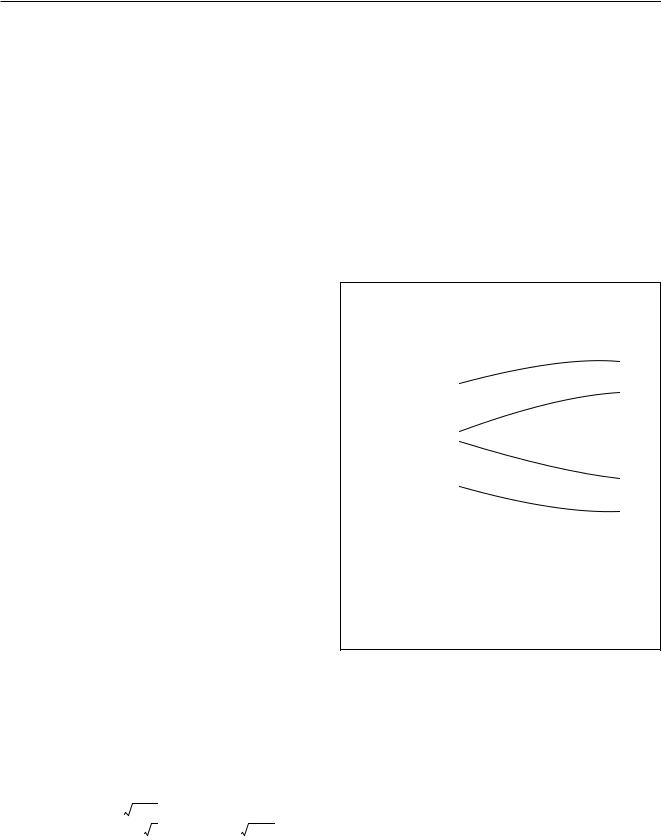
Philips Semiconductors |
Product specification |
|
|
LCD row/column driver for dot matrix
PCF8578
graphic displays
7.3Multiplexed LCD bias generation
The bias levels required to produce maximum contrast depend on the multiplex rate and the LCD threshold voltage (Vth). Vth is typically defined as the RMS voltage at which the LCD exhibits 10% contrast. Table 2 shows the optimum voltage bias levels for the PCF8578 as functions of Vop (Vop = VDD − VLCD), together with the discrimination ratios (D) for the different multiplex rates. A practical value
for Vop is obtained by equating Voff(rms) with Vth. Figure 4 shows the first 4 rows of Table 2 as graphs. Table 3 shows
the relative values of the resistors required in the configuration of Fig.5 to produce the standard multiplex rates.
Table 2 Optimum LCD voltages
PARAMETER |
|
MULTIPLEX RATE |
|
||
|
|
|
|
||
1 : 8 |
1 : 16 |
1 : 24 |
1 : 32 |
||
|
|||||
|
|
|
|
|
|
V2 |
0.739 |
0.800 |
0.830 |
0.850 |
|
--------- |
|||||
Vop |
|
|
|
|
|
V3 |
0.522 |
0.600 |
0.661 |
0.700 |
|
--------- |
|||||
Vop |
|
|
|
|
|
V4 |
0.478 |
0.400 |
0.339 |
0.300 |
|
--------- |
|||||
Vop |
|
|
|
|
|
V5 |
0.261 |
0.200 |
0.170 |
0.150 |
|
--------- |
|||||
Vop |
|
|
|
|
|
Voff ( rms) |
0.297 |
0.245 |
0.214 |
0.193 |
|
----------------------- |
|||||
Vop |
|
|
|
|
|
Von ( rms) |
0.430 |
0.316 |
0.263 |
0.230 |
|
---------------------- |
|||||
Vop |
|
|
|
|
|
Von ( rms) |
1.447 |
1.291 |
1.230 |
1.196 |
|
D = ----------------------- |
|||||
Voff ( rms) |
|
|
|
|
|
Vop |
3.370 |
4.080 |
4.680 |
5.190 |
|
--------- |
|||||
Vth |
|
|
|
|
|
Table 3 Multiplex rates and resistor values for Fig.5
RESISTORS |
MULTIPLEX RATE (n) |
||
|
|
||
n = 8 |
n = 16, 24, 32 |
||
|
|||
|
|
|
|
R1 |
R |
R |
|
|
|
|
|
R2 |
( n –2) R |
R |
|
R3 |
( 3 – n) R |
( n –3) R |
|
7.4Power-on reset
At power-on the PCF8578 resets to a defined starting condition as follows:
1.Display blank
2.1 : 32 multiplex rate, row mode
3.Start bank, 0 selected
4.Data pointer is set to X, Y address 0, 0
5.Character mode
6.Subaddress counter is set to 0
7.I2C-bus interface is initialized.
Data transfers on the I2C-bus should be avoided for 1 ms following power-on, to allow completion of the reset action.
MSA838
V bias |
1.0 |
|
|
|
|
|
|
|
|
|
|
||
|
|
|
|
|
|
|
|
|
|
||||
|
|
|
|
|
|
|
|
|
|
|
|||
|
Vop |
|
|
|
|
|
|
|
V2 |
|
|
|
|
|
|
|
0.8 |
|
|
|
|
|
|
|
|
|
|
|
|
|
|
|
|
|
|
|
|
|
|
|
|
|
|
|
|
|
|
|
|
|
|
|
|
|
|
|
|
|
|
|
|
|
|
|
V3 |
|
|
|
|
|
|
|
0.6 |
|
|
|
|
|
|
|
|
|
|
|
|
|
|
|
|
|
|
|
|
|
|
|
|
|
|
|
0.4 |
|
|
|
|
|
|
|
|
|
|
|
|
|
|
|
|
|
|
|
|
|
|
|
|
|
|
|
|
|
|
|
|
V4 |
|
|
|
|
|
|
|
|
|
|
|
|
|
|
|
|
|
|
|
|
|
|
0.2 |
|
|
|
|
|
|
|
|
|
|
|
|
|
|
|
|
|
|
V5 |
|
|
|
|
|
|
|
|
|
|
|
|
|
|
|
|
|
|
|
|
|
|
0 |
|
|
|
|
|
|
|
|
|
|
|
|
|
|
|
|
|
|
|
|
|
|
|
|
|
|
|
1:8 |
|
1:16 |
1:24 |
1:32 |
||||||
|
|
|
|
|
|
|
|
|
|
multiplex rate |
|||
Vbias = V2, V3, V4, V5. See Table 2. |
|
|
|
|
|
|
|||||||
Fig.4 |
Vbias/Vop as a function of the multiplex rate. |
||||||||||||
1998 Sep 08 |
9 |
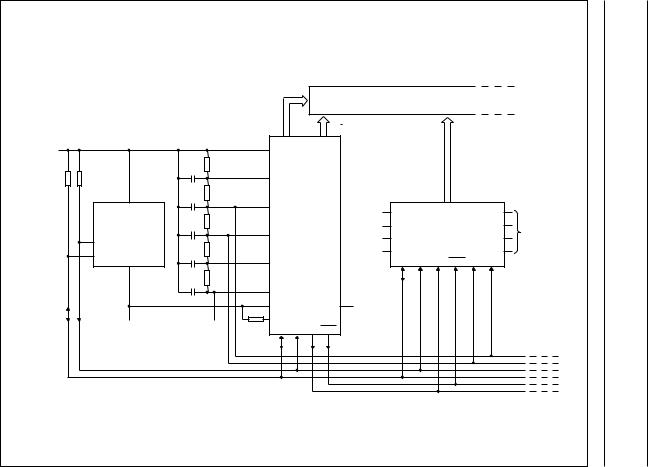
_ |
|
|
|
|
|
|
|
|
|
|
08 Sep 1998 |
|
|
|
|
|
|
|
|
|
|
|
|
|
|
|
|
|
LCD DISPLAY |
|
|
|
|
|
|
|
n |
40 |
n |
|
|
|
|
|
|
|
|
rows |
columns |
|
|
|
|
|
VDD |
|
|
VDD |
|
|
|
|
|
|
|
|
R1 |
|
|
|
|
|
|
40 |
|
|
|
|
|
|
|
|
|
columns |
|
|
|
|
C |
|
|
|
|
|
|
|
|
|
|
|
|
V2 |
|
|
|
|
|
|
|
|
R2 |
|
|
|
|
|
|
|
|
|
|
C |
|
|
|
|
|
|
|
|
|
|
|
|
V3 |
|
|
VDD |
VDD |
|
A0 |
|
HOST |
R3 |
|
|
|
|
|
|
|||
MICROCONTROLLER |
|
|
|
|
VLCD |
VLCD |
|
A1 |
|
|
C |
|
|
|
|
|
subaddress 1 |
||||
10 |
|
|
V4 |
PCF8578 |
VSS |
VSS |
PCF8579 |
A2 |
VSS / VDD |
|
SCL |
|
|
|
|
|
|
|
|||
R2 |
|
|
|
|
VSS / VDD |
|
|
|
|
|
|
|
|
|
|
SA0 |
|
A3 |
|
||
SDA |
C |
|
|
|
|
|
|
CLK SYNC V4 V3 |
|
|
|
|
|
|
|
|
SDA SCL |
|
|||
|
|
|
V5 |
|
|
|
|
|||
|
|
|
|
|
|
|
|
|
|
|
|
R1 |
|
|
|
|
|
|
|
|
|
|
C |
|
|
|
|
|
|
|
|
|
|
|
|
VLCD |
|
|
|
|
|
|
|
|
|
|
VSS |
|
SA0 |
VSS / VDD |
|
|
|
|
VSS |
VLCD |
R |
OSC |
|
|
|
|
|
|
|
OSC SDA |
SCL |
CLK SYNC |
|
|
|
|
|
|||
|
|
|
|
|
|
|
|
|||
MSA843
Fig.5 Typical mixed mode configuration.
matrix dot for driver row/column LCD displays graphic
PCF8578
Semiconductors Philips
specification Product
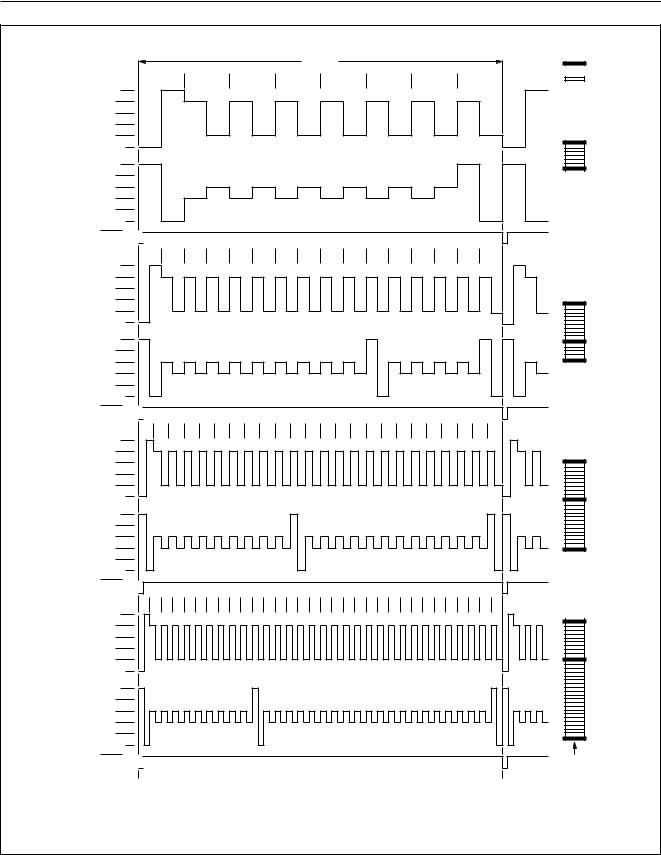
Philips Semiconductors |
Product specification |
|
|
LCD row/column driver for dot matrix
PCF8578
graphic displays
T frame
0 |
1 |
2 |
3 |
4 |
5 |
6 |
7 |
VDD
V 2
V3
ROW 0 V4
V5
VLCD
VDD
V 2
V3
COLUMN V4
V5
VLCD
SYNC 


0 |
1 |
2 |
3 |
4 |
5 |
6 |
7 |
8 |
9 |
10 |
11 |
12 |
13 |
14 |
15 |
VDD
V 2
V3
ROW 0 V4
V5
VLCD
VDD
V 2
V3
COLUMN V4
V5
VLCD
SYNC 


0 |
1 |
2 |
3 |
4 |
5 |
6 |
7 |
8 |
9 |
10 |
11 |
12 |
13 |
14 |
15 |
16 |
17 |
18 |
19 |
20 |
21 |
22 |
23 |
VDD
V 2
V3
ROW 0 V4
V5
VLCD
VDD
V 2
V3
COLUMN V4
V5
VLCD
SYNC 

0 1 2 3 4 5 6 7 8 9 10 11 12 13 14 15 16 17 18 19 20 21 22 23 24 25 26 27 28 29 30 31
VDD
V 2
V3 ROW 0 V4 V5
VLCD
VDD
V 2
V3
COLUMN V4
V5
VLCD
SYNC 


MSA841
ON
OFF
1:8
1:16
1:24
1:32
column display
Fig.6 LCD row/column waveforms.
1998 Sep 08 |
11 |

Philips Semiconductors |
Product specification |
|
|
LCD row/column driver for dot matrix
PCF8578
graphic displays
ROW 1
R1 (t)
ROW 2
R2 (t)
COL 1
C1 (t)
COL 2
C2 (t)
V state 1 (t)
V state 2 (t)
T frame
VDD
V2
V3 V4 V5
VLCD
VDD
V2
V3
V4
V5
VLCD
VDD
V2
V3
V4
V5
VLCD
VDD
V2
V3
V4
V5
VLCD
Vop
0.261 Vop
0 V
0.261 Vop
Vop
Vop
0.478 Vop
0.261 Vop
0 V
0.261 Vop
0.478 Vop
Vop
Vstate 1 |
(t) = C1(t) |
|
R1(t): |
|
|
|||||||||
|
|
|
||||||||||||
Von(rms) |
= |
1 |
|
|
|
8 |
|
|
1 |
|
= 0.430 |
|||
|
|
|
|
|
||||||||||
Vop |
|
8 |
|
|
|
8 ( |
8 |
|
|
|
1) |
|||
Vstate 2 |
(t) = C2(t) |
|
R2(t): |
|
|
|||||||||
|
|
|
||||||||||||
|
Voff(rms) |
= |
2 ( 8 |
1) |
= 0.297 |
|||
|
8 ( |
|
|
|
1) 2 |
|||
|
Vop |
8 |
|
|
|
|||
state 1 (OFF)
state 2 (ON)
dot matrix
1:8 multiplex rate
MSA840
general relationship (n = multiplex rate)
Von(rms) = |
1 |
|
n |
1 |
||
Vop |
|
n |
n ( |
n |
1) |
|
Voff(rms) |
= |
2 ( |
n |
1) |
||
Vop |
n ( |
n |
1) 2 |
|||
|
||||||
Fig.7 LCD drive mode waveforms for 1 : 8 multiplex rate.
1998 Sep 08 |
12 |
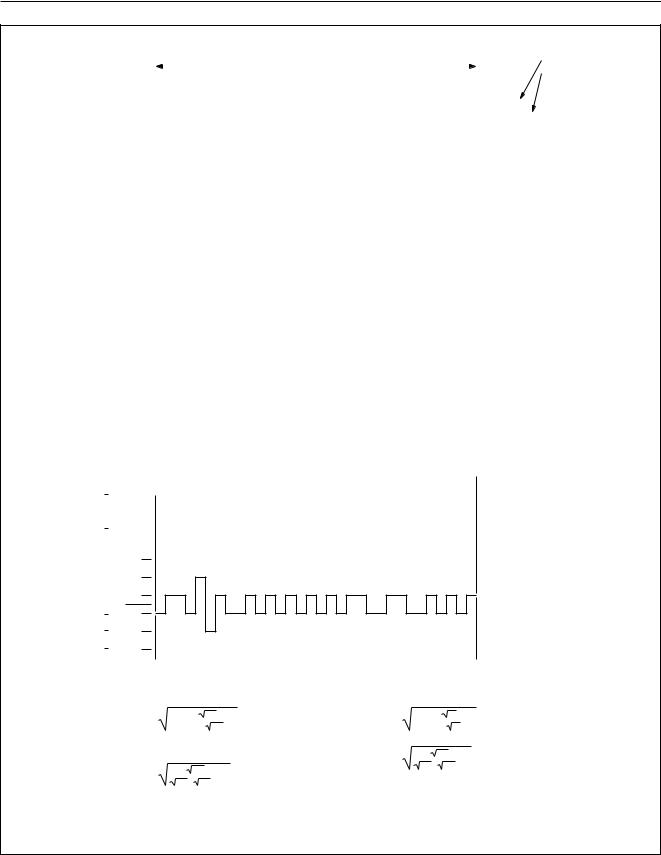
Philips Semiconductors |
Product specification |
|
|
LCD row/column driver for dot matrix
PCF8578
graphic displays
ROW 1
R1 (t)
ROW 2
R2 (t)
COL 1
C1 (t)
COL 2
C2 (t)
V state 1 (t)
V state 2 (t)
|
|
|
|
|
|
|
|
|
|
|
|
|
|
|
|
|
|
|
|
T frame |
|
|
|
|
|
|
|
|
|
|
|
|
|
|
|
|
|
|
|
|
|
|
|
state 1 (OFF) |
|||||||
|
|
|
|
|
|
|
|
|
|
|
|
|
|
|
|
|
|
|
|
|
|
|
|
|
|
|
|
|
|
|
|
|
|
|
|
|
|
|
|
|
|
|
|||||||||
VDD |
|
|
|
|
|
|
|
|
|
|
|
|
|
|
|
|
|
|
|
|
|
|
|
|
|
|
|
state 2 (ON) |
|||||||||||||||||||||||
|
|
|
|
|
|
|
|
|
|
|
|
|
|
|
|
|
|
|
|
|
|
|
|
|
|
|
|
|
|
|
|
|
|
|
|
|
|
|
|
|
|
|
|
||||||||
|
|
|
|
|
|
|
|
|
|
|
|
|
|
|
|
|
|
|
|
|
|
|
|
|
|
|
|
|
|
|
|
|
|
|
|
|
|
|
|
|
|
|
|
|
|
|
|
|
|||
V2 |
|
|
|
|
|
|
|
|
|
|
|
|
|
|
|
|
|
|
|
|
|
|
|
|
|
|
|
|
|
|
|
|
|
|
|
|
|
|
|
|
|
|
|
|
|
|
|
|
|
|
|
|
|
|
|
|
|
|
|
|
|
|
|
|
|
|
|
|
|
|
|
|
|
|
|
|
|
|
|
|
|
|
|
|
|
|
|
|
|
|
|
|
|
|
|
|
|
|
|
|
|
||
V3 |
|
|
|
|
|
|
|
|
|
|
|
|
|
|
|
|
|
|
|
|
|
|
|
|
|
|
|
|
|
|
|
|
|
|
|
|
|
|
|
|
|
|
|
|
|
|
|
|
|
||
|
|
|
|
|
|
|
|
|
|
|
|
|
|
|
|
|
|
|
|
|
|
|
|
|
|
|
|
|
|
|
|
|
|
|
|
|
|
|
|
|
|
|
|
|
|
|
|
|
|
||
V4 |
|
|
|
|
|
|
|
|
|
|
|
|
|
|
|
|
|
|
|
|
|
|
|
|
|
|
|
|
|
|
|
|
|
|
|
|
|
|
|
|
|
|
|
|
|
|
|
|
|
||
|
|
|
|
|
|
|
|
|
|
|
|
|
|
|
|
|
|
|
|
|
|
|
|
|
|
|
|
|
|
|
|
|
|
|
|
|
|
|
|
|
|
|
|
|
|
|
|
|
|||
V5 |
|
|
|
|
|
|
|
|
|
|
|
|
|
|
|
|
|
|
|
|
|
|
|
|
|
|
|
|
|
|
|
|
|
|
|
|
|
|
|
|
|
|
|
|
|
|
|
|
|
|
|
|
|
|
|
|
|
|
|
|
|
|
|
|
|
|
|
|
|
|
|
|
|
|
|
|
|
|
|
|
|
|
|
|
|
|
|
|
|
|
|
|
|
|
|
|
|
|
|
|
|
||
VLCD |
|
|
|
|
|
|
|
|
|
|
|
|
|
|
|
|
|
|
|
|
|
|
|
|
|
|
|
|
|
|
|
|
|
|
|
|
|
|
|
|
|
|
|
|
|
|
|
|
|||
|
|
|
|
|
|
|
|
|
|
|
|
|
|
|
|
|
|
|
|
|
|
|
|
|
|
|
|
|
|
|
|
|
|
|
|
|
|
|
|
|
|
|
|
|
|
|
|
||||
VDD |
|
|
|
|
|
|
|
|
|
|
|
|
|
|
|
|
|
|
|
|
|
|
|
|
|
|
|
|
|
|
|
|
|
|
|
|
|
|
|
|
|
|
|
|
|
|
|
|
|
||
|
|
|
|
|
|
|
|
|
|
|
|
|
|
|
|
|
|
|
|
|
|
|
|
|
|
|
|
|
|
|
|
|
|
|
|
|
|
|
|
|
|
|
|
|
|
|
|
|
|||
|
|
|
|
|
|
|
|
|
|
|
|
|
|
|
|
|
|
|
|
|
|
|
|
|
|
|
|
|
|
|
|
|
|
|
|
|
|
|
|
|
|
|
|
|
|
|
|
|
|||
V2 |
|
|
|
|
|
|
|
|
|
|
|
|
|
|
|
|
|
|
|
|
|
|
|
|
|
|
|
|
|
|
|
|
|
|
|
|
|
|
|
|
|
|
|
|
|
|
|
|
|
|
|
V3 |
|
|
|
|
|
|
|
|
|
|
|
|
|
|
|
|
|
|
|
|
|
|
|
|
|
|
|
|
|
|
|
|
|
|
|
|
|
|
|
|
|
|
|
|
|
|
|
|
|
|
|
|
|
|
|
|
|
|
|
|
|
|
|
|
|
|
|
|
|
|
|
|
|
|
|
|
|
|
|
|
|
|
|
|
|
|
|
|
|
|
|
|
|
|
|
|
|
|
|
||||
V4 |
|
|
|
|
|
|
|
|
|
|
|
|
|
|
|
|
|
|
|
|
|
|
|
|
|
|
|
|
|
|
|
|
|
|
|
|
|
|
|
|
|
|
|
|
|
|
|
|
|
|
|
|
|
|
|
|
|
|
|
|
|
|
|
|
|
|
|
|
|
|
|
|
|
|
|
|
|
|
|
|
|
|
|
|
|
|
|
|
|
|
|
|
|
|
|
|
|
|
|
||||
V5 |
|
|
|
|
|
|
|
|
|
|
|
|
|
|
|
|
|
|
|
|
|
|
|
|
|
|
|
|
|
|
|
|
|
|
|
|
|
|
|
|
|
|
|
|
|
|
|
|
|
|
|
VLCD |
|
|
|
|
|
|
|
|
|
|
|
|
|
|
|
|
|
|
|
|
|
|
|
|
|
|
|
|
|
|
|
|
|
|
|
|
|
|
|
|
|
|
|
|
|
|
|
|
|||
|
|
|
|
|
|
|
|
|
|
|
|
|
|
|
|
|
|
|
|
|
|
|
|
|
|
|
|
|
|
|
|
|
|
|
|
|
|
|
|
|
|
|
|
|
|
|
|
||||
VDD |
|
|
|
|
|
|
|
|
|
|
|
|
|
|
|
|
|
|
|
|
|
|
|
|
|
|
|
|
|
|
|
|
|
|
|
|
|
|
|
|
|
|
|
|
|
|
|
|
|
||
|
|
|
|
|
|
|
|
|
|
|
|
|
|
|
|
|
|
|
|
|
|
|
|
|
|
|
|
|
|
|
|
|
|
|
|
|
|
|
|
|
|
|
|
|
|
|
|
|
|||
|
|
|
|
|
|
|
|
|
|
|
|
|
|
|
|
|
|
|
|
|
|
|
|
|
|
|
|
|
|
|
|
|
|
|
|
|
|
|
|
|
|
|
|
|
|
|
|
|
|||
V2 |
|
|
|
|
|
|
|
|
|
|
|
|
|
|
|
|
|
|
|
|
|
|
|
|
|
|
|
|
|
|
|
|
|
|
|
|
|
|
|
|
|
|
|
|
|
|
|
|
|||
|
|
|
|
|
|
|
|
|
|
|
|
|
|
|
|
|
|
|
|
|
|
|
|
|
|
|
|
|
|
|
|
|
|
|
|
|
|
|
|
|
|
|
|
|
|
|
|
||||
V3 |
|
|
|
|
|
|
|
|
|
|
|
|
|
|
|
|
|
|
|
|
|
|
|
|
|
|
|
|
|
|
|
|
|
|
|
|
|
|
|
|
|
|
|
|
|
|
|
|
|
|
|
|
|
|
|
|
|
|
|
|
|
|
|
|
|
|
|
|
|
|
|
|
|
|
|
|
|
|
|
|
|
|
|
|
|
|
|
|
|
|
|
|
|
|
|
|
|
|
|
|
|
||
V4 |
|
|
|
|
|
|
|
|
|
|
|
|
|
|
|
|
|
|
|
|
|
|
|
|
|
|
|
|
|
|
|
|
|
|
|
|
|
|
|
|
|
|
|
|
|
|
|
|
|||
|
|
|
|
|
|
|
|
|
|
|
|
|
|
|
|
|
|
|
|
|
|
|
|
|
|
|
|
|
|
|
|
|
|
|
|
|
|
|
|
|
|
|
|
|
|
|
|
|
|
||
V5 |
|
|
|
|
|
|
|
|
|
|
|
|
|
|
|
|
|
|
|
|
|
|
|
|
|
|
|
|
|
|
|
|
|
|
|
|
|
|
|
|
|
|
dot matrix |
||||||||
|
|
|
|
|
|
|
|
|
|
|
|
|
|
|
|
|
|
|
|
|
|
|
|
|
|
|
|
|
|
|
|
|
|
|
|
|
|
|
|
||||||||||||
VLCD |
|
|
|
|
|
|
|
|
|
|
|
|
|
|
|
|
|
|
|
|
|
|
|
|
|
|
|
|
|
|
|
|
|
|
|
|
|
|
|
|
1:16 multiplex rate |
||||||||||
|
|
|
|
|
|
|
|
|
|
|
|
|
|
|
|
|
|
|
|
|
|
|
|
|
|
|
|
|
|
|
|
|
|
|
|
|
|
|
|
||||||||||||
VDD |
|
|
|
|
|
|
|
|
|
|
|
|
|
|
|
|
|
|
|
|
|
|
|
|
|
|
|
|
|
|
|
|
|
|
|
|
|
|
|
|
|
|
|
|
|
|
|
|
|||
|
|
|
|
|
|
|
|
|
|
|
|
|
|
|
|
|
|
|
|
|
|
|
|
|
|
|
|
|
|
|
|
|
|
|
|
|
|
|
|
|
|
|
|
|
|
|
|
|
|||
V2 |
|
|
|
|
|
|
|
|
|
|
|
|
|
|
|
|
|
|
|
|
|
|
|
|
|
|
|
|
|
|
|
|
|
|
|
|
|
|
|
|
|
|
|
|
|
|
|
|
|||
|
|
|
|
|
|
|
|
|
|
|
|
|
|
|
|
|
|
|
|
|
|
|
|
|
|
|
|
|
|
|
|
|
|
|
|
|
|
|
|
|
|
|
|
|
|
|
|
||||
V3 |
|
|
|
|
|
|
|
|
|
|
|
|
|
|
|
|
|
|
|
|
|
|
|
|
|
|
|
|
|
|
|
|
|
|
|
|
|
|
|
|
|
|
|
|
|
|
|
|
|||
|
|
|
|
|
|
|
|
|
|
|
|
|
|
|
|
|
|
|
|
|
|
|
|
|
|
|
|
|
|
|
|
|
|
|
|
|
|
|
|
|
|
|
|
|
|
|
|
|
|
||
|
|
|
|
|
|
|
|
|
|
|
|
|
|
|
|
|
|
|
|
|
|
|
|
|
|
|
|
|
|
|
|
|
|
|
|
|
|
|
|
|
|
|
|
|
|
|
|
|
|
||
V4 |
|
|
|
|
|
|
|
|
|
|
|
|
|
|
|
|
|
|
|
|
|
|
|
|
|
|
|
|
|
|
|
|
|
|
|
|
|
|
|
|
|
|
|
|
|
|
|
|
|||
|
|
|
|
|
|
|
|
|
|
|
|
|
|
|
|
|
|
|
|
|
|
|
|
|
|
|
|
|
|
|
|
|
|
|
|
|
|
|
|
|
|
|
|
|
|
|
|
|
|
||
V5 |
|
|
|
|
|
|
|
|
|
|
|
|
|
|
|
|
|
|
|
|
|
|
|
|
|
|
|
|
|
|
|
|
|
|
|
|
|
|
|
|
|
|
|
|
|
|
|
|
|||
|
|
|
|
|
|
|
|
|
|
|
|
|
|
|
|
|
|
|
|
|
|
|
|
|
|
|
|
|
|
|
|
|
|
|
|
|
|
|
|
|
|
|
|
|
|
|
|
||||
VLCD |
|
|
|
|
|
|
|
|
|
|
|
|
|
|
|
|
|
|
|
|
|
|
|
|
|
|
|
|
|
|
|
|
|
|
|
|
|
|
|
|
|
|
|
|
|
|
|
|
|||
|
|
|
|
|
|
|
|
|
|
|
|
|
|
|
|
|
|
|
|
|
|
|
|
|
|
|
|
|
|
|
|
|
|
|
|
|
|
|
|
|
|
|
|
|
|
|
|
||||
Vop |
|
|
|
|
|
|
|
|
|
|
|
|
|
|
|
|
|
|
|
|
|
|
|
|
|
|
|
|
|
|
|
|
|
|
|
|
|
|
|
|
|
|
|
|
|
|
|
|
|||
|
|
|
|
|
|
|
|
|
|
|
|
|
|
|
|
|
|
|
|
|
|
|
|
|
|
|
|
|
|
|
|
|
|
|
|
|
|
|
|
|
|
|
|
|
|
|
|
||||
0.2 Vop |
|
|
|
|
|
|
|
|
|
|
|
|
|
|
|
|
|
|
|
|
|
|
|
|
|
|
|
|
|
|
|
|
|
|
|
|
|
|
|
|
|
|
|
|
|
|
|
|
|||
|
|
|
|
|
|
|
|
|
|
|
|
|
|
|
|
|
|
|
|
|
|
|
|
|
|
|
|
|
|
|
|
|
|
|
|
|
|
|
|
|
|
|
|
|
|
|
|
||||
0 V |
|
|
|
|
|
|
|
|
|
|
|
|
|
|
|
|
|
|
|
|
|
|
|
|
|
|
|
|
|
|
|
|
|
|
|
|
|
|
|
|
|
|
|
|
|
|
|
|
|
|
|
|
|
|
|
|
|
|
|
|
|
|
|
|
|
|
|
|
|
|
|
|
|
|
|
|
|
|
|
|
|
|
|
|
|
|
|
|
|
|
|
|
|
|
|
|
|
|
|
||||
0.2 Vop |
|
|
|
|
|
|
|
|
|
|
|
|
|
|
|
|
|
|
|
|
|
|
|
|
|
|
|
|
|
|
|
|
|
|
|
|
|
|
|
|
|
|
|
|
|
|
|
|
|||
|
|
|
|
|
|
|
|
|
|
|
|
|
|
|
|
|
|
|
|
|
|
|
|
|
|
|
|
|
|
|
|
|
|
|
|
|
|
|
|
|
|
|
|
|
|
|
|
||||
Vop |
|
|
|
|
|
|
|
|
|
|
|
|
|
|
|
|
|
|
|
|
|
|
|
|
|
|
|
|
|
|
|
|
|
|
|
|
|
|
|
|
|
|
|
|
|
|
|
|
|||
|
|
|
|
|
|
|
|
|
|
|
|
|
|
|
|
|
|
|
|
|
|
|
|
|
|
|
|
|
|
|
|
|
|
|
|
|
|
|
|
|
|
|
|
|
|
|
|
||||
Vop
0.6 Vop
0.2 Vop
0 V
0.2 Vop
0.6 Vop
Vop
|
|
|
|
|
|
|
|
|
|
|
|
|
|
|
|
|
|
|
|
|
|
|
|
|
|
|
|
|
|
|
|
|
|
|
|
|
|
|
|
|
|
|
MSA836 |
Vstate 1 (t) = C1(t) |
|
R1(t): |
|
|
|
|
|
|
|
|
general relationship (n = multiplex rate) |
||||||||||||||||||||||||||||||||
|
|
|
|
|
|
|
|
||||||||||||||||||||||||||||||||||||
Von(rms) |
= |
1 |
|
|
|
16 |
|
|
1 |
|
|
|
= 0.316 |
Von(rms) |
= |
|
1 |
|
|
|
|
n |
|
|
1 |
|
|
||||||||||||||||
|
|
|
|
|
|
|
|
|
|
|
|
||||||||||||||||||||||||||||||||
|
|
|
|
|
|
|
|
|
|
|
|
|
|
|
|
|
|
|
|
|
|
|
|
|
|
|
|
|
|
|
|
|
|
|
|
|
|
|
|
|
|||
|
V |
|
|
|
|
|
( |
|
|
|
|
|
|
|
|
|
|
) |
|
V |
|
|
|
|
|
( |
|
|
|
|
|
|
|
|
|
) |
|||||||
|
|
op |
|
16 |
|
16 |
|
|
16 |
|
|
1 |
|
|
|
|
op |
|
|
n |
|
n |
|
|
n |
|
|
1 |
|
||||||||||||||
Vstate 2 (t) = C2(t) |
|
R2(t): |
|
|
|
|
|
|
|
Voff(rms) |
= |
|
2 ( |
|
n |
|
1) |
|
|
|
|
|
|
|
|||||||||||||||||||
|
|
|
|
|
|
|
|
|
|
||||||||||||||||||||||||||||||||||
|
|
|
|
|
|
|
|
|
|
|
|
|
|
|
|
|
|
|
|
|
|
|
|
|
|||||||||||||||||||
|
|
|
|
|
|
|
|
|
|
|
|
|
|
|
|
|
|
|
|
|
|
|
|
|
|
|
|
|
|
|
|
|
|
|
|
|
|
|
|
|
|
|
|
V |
off(rms) |
= |
2 ( |
16 |
|
1) |
|
|
|
|
= 0.254 |
|
Vop |
|
|
n ( |
|
n |
|
|
|
1) 2 |
|
||||||||||||||||||||
|
|
|
|
|
|
|
|
|
|
|
|
|
|
||||||||||||||||||||||||||||||
|
|
|
|
|
|
|
|
|
|
|
|
|
|
|
|
|
|
|
|
|
|
|
|
|
|
|
|
|
|||||||||||||||
|
Vop |
16 |
( 16 |
|
|
|
1) 2 |
|
|
|
|
|
|
|
|
|
|
|
|
|
|
|
|
|
|
|
|
|
|
|
|||||||||||||
|
|
|
|
|
|
|
|
|
|
|
|
|
|
|
|
|
|
|
|
|
|
|
|
|
|
|
|
|
|
|
|||||||||||||
Fig.8 LCD drive mode waveforms for 1 : 16 multiplex rate.
1998 Sep 08 |
13 |
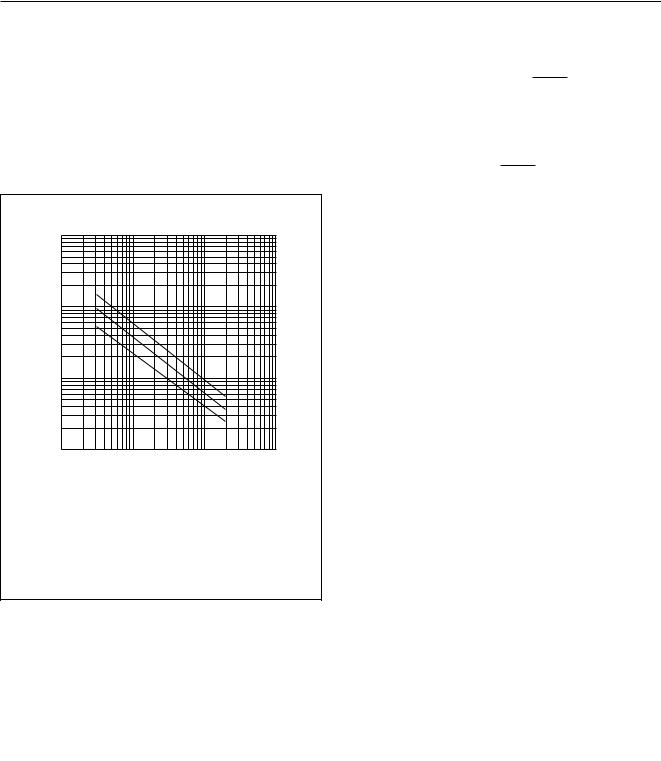
Philips Semiconductors |
Product specification |
|
|
LCD row/column driver for dot matrix
PCF8578
graphic displays
7.5Internal clock
The clock signal for the system may be generated by the internal oscillator and prescaler. The frequency is determined by the value of the resistor ROSC, see Fig.9. For normal use a value of 330 kW is recommended.
The clock signal, for cascaded PCF8579s, is output at CLK and has a frequency 1¤6 (multiplex rate 1 : 8, 1 : 16 and
1 : 32) or 1¤8 (multiplex rate 1 : 24) of the oscillator frequency.
MSA837
10 3
f OSC (kHz)
102
10
1
10 102 103 104 R OSC (kΩ )
To avoid capacitive coupling, which could adversely affect oscillator stability, ROSC should be placed as closely as possible to the OSC pin. If this proves to be a problem, a filtering capacitor may be connected in parallel to ROSC.
Fig.9 Oscillator frequency as a function of external oscillator resistor, ROSC.
7.6External clock
If an external clock is used, OSC must be connected to VDD and the external clock signal to CLK. Table 4
summarizes the nominal CLK and SYNC frequencies.
7.7Timing generator
The timing generator of the PCF8578 organizes the internal data flow of the device and generates the LCD frame synchronization pulse SYNC, whose period is an integer multiple of the clock period. In cascaded applications, this signal maintains the correct timing relationship between the PCF8578 and PCF8579s in the system.
7.8Row/column drivers
Outputs R0 to R7 and C32 to C39 are fixed as row and column drivers respectively. The remaining 24 outputs R8/C8 to R31/C31 are programmable and may be configured (in blocks of 8) to be either row or column drivers. The row select signal is produced sequentially at each output from R0 up to the number defined by the multiplex rate (see Table 1). In mixed mode the remaining outputs are configured as columns. In row mode all programmable outputs (R8/C8 to R31/C31) are defined as row drivers and the outputs C32 to C39 should be left open-circuit.
Using a 1 : 16 multiplex rate, two sets of row outputs are driven, thus facilitating split-screen configurations, i.e. a row select pulse appears simultaneously at R0 and R16/C16, R1 and R17/C17 etc. Similarly, using a multiplex rate of 1 : 8, four sets of row outputs are driven simultaneously. Driver outputs must be connected directly to the LCD. Unused outputs should be left open-circuit. In 1 : 8 R0 to R7 are rows; in 1 : 16 R0 to R15/C15 are rows; in 1 : 24 R0 to R23/C23 are rows; in 1 : 32
R0 to R31/C31 are rows.
Table 4 Signal frequencies required for nominal 64 Hz frame frequency; note 1.
OSCILLATOR |
FRAME FREQUENCY |
|
DIVISION |
CLOCK FREQUENCY |
||||
FREQUENCY |
MULTIPLEX RATE (n) |
|||||||
f |
|
(Hz) |
RATIO |
fCLK (Hz) |
||||
f |
(2) (Hz) |
SYNC |
|
|||||
|
OSC |
|
|
|
|
|
|
|
|
12288 |
64 |
1 : 8, 1 : 16, 1 : 32 |
6 |
2048 |
|||
|
|
|
|
|
|
|||
|
12288 |
64 |
1 : 24 |
8 |
1536 |
|||
|
|
|
|
|
|
|
|
|
Notes
1.A clock signal must always be present, otherwise the LCD may be frozen in a DC state.
2.ROSC = 330 kW.
1998 Sep 08 |
14 |
